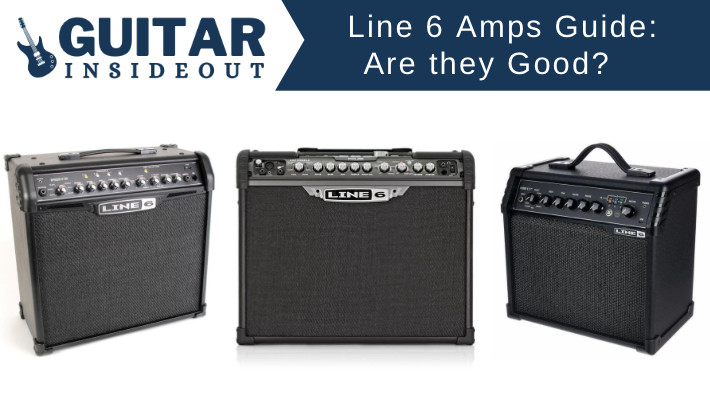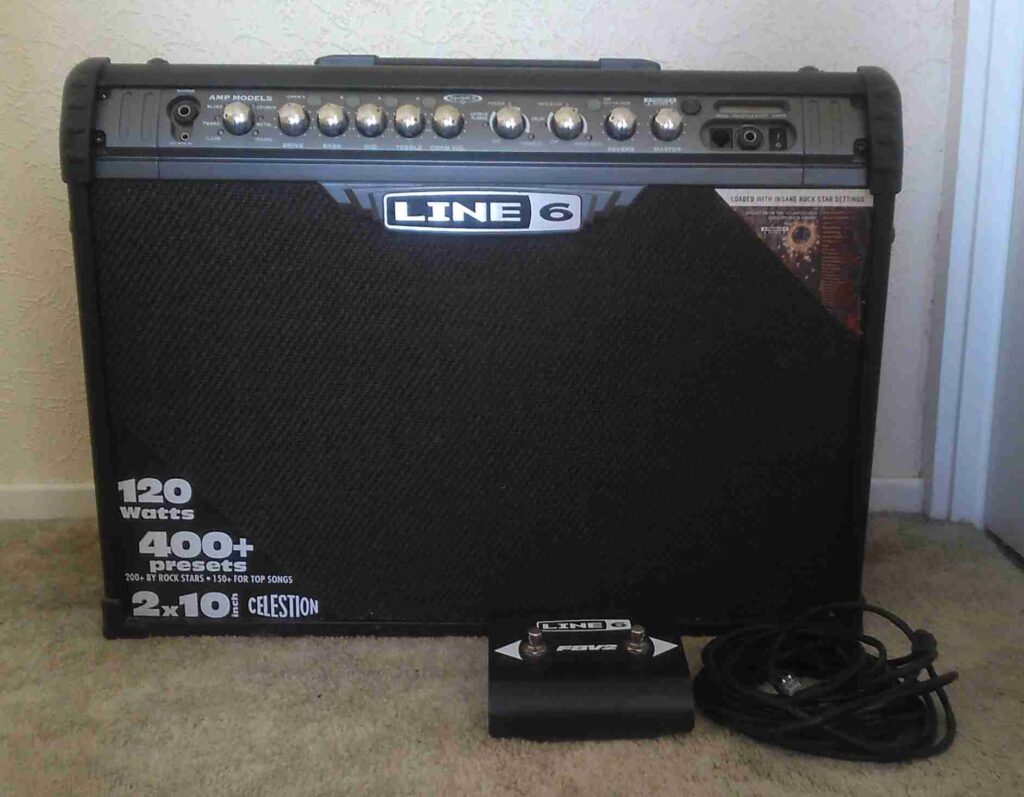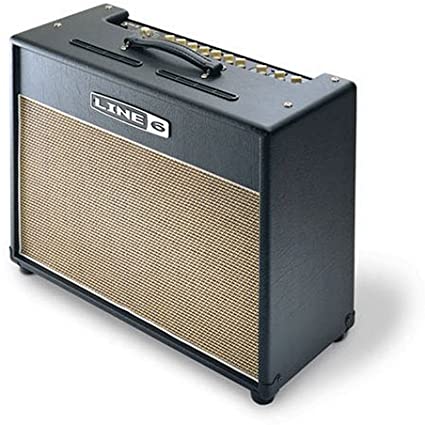Line 6 have become one of the most successful musical instrument and audio companies out there. If you’ve been playing the guitar for even a short time you’ll no doubt be somewhat familiar with Line 6.
Their Spider range of guitar amps is hugely popular and one of the biggest selling amplifiers on the market. They’re pedals and wireless systems are also widely used.
Basically they’re a massive deal.

But the guitar and music world can be a bit snobbish. And Line 6, especially their amps, have picked up a reputation for not being very good. In fact in a lot of guitar circles Line 6 amps are a bit of a joke.
But is that fair? Do Line 6 deserve to be a bit of a punchline? Are they really that bad?
Well let’s take a closer look at Line 6 amps – where they’re made, what they sound like and whether they’re as bad as they’re made out to be.
History of Line 6 Amplifiers
Founded in 1996 by Marcus Ryle and Michel Doidic, Line 6’s rise has been swift. Originally the duo were design engineers at Oberhreim in the 1980’s before co-founding the pro audio company Fast Forward.
It wasn’t long until they began working on guitar and amp related products on the side though. This led to the launching of Line 6 in 1996 and their first product, the AxSys 212, a digital modelling combo amp using two 12″ speakers. It was quickly followed by the Flextone amp in 1997.
It was 1998 that the POD was launched, a new take on the multi-effects unit. By the early 2000’s the POD really began to take off and put Line 6 on the map.

Not long after followed the Spider series of amps which due to their affordable price also found a huge audience of beginner players. Since then Line 6 has continued to innovate and expand with the massive success of the Helix effects units and their leading wireless system.
We’re all about giving you access to the tools you need to create, perform and record in ways you never thought possible. We promise that we’ll always take dramatic leaps so you can reach new heights with your music. That’s our commitment to you, because in the end, we love being a part of making great music. – Line 6 Story, from their website
Read the entire History of Line 6.
Who Makes Line 6 Amps
Line 6 Amplifiers are made by Yamaha. In 2014 Yamaha bought Line 6 and soon after created the Guitar Group subsidiary which markets all of Yamaha and Line 6’s guitar products globally.
Where are Line 6 Amps Made
Manufacturing of Line 6 amps is in China. In fact all Line 6 products are manufactured in China.
The research and development takes place near California but to save costs China is where all Line 6 gear, including their amps, is made.
Whilst many find the idea of music equipment being made in China a sign of poor quality it is the reality nowadays. Most Orange amps, Marshall’s, Fender’s and more are made in China.
Yes, American or British made is considered higher quality but there are plenty of good Chinese made guitars and amplifiers being used every day without any issues.
So don’t judge Line 6 too harshly.

Which Artists Play Line 6 Amps
There are very few, if any, major artists using Line 6 amps live (odd exceptions aside). Their amps, the Spider and Catalyst range, are more suited to beginner or home players.
However, the Helix processor has become extremely popular amongst many world famous artists. And the Relay wireless system is also very widely used.
Here are just a few that use the Helix for recording and playing live:
- Bill Kelliher of Mastodon
- Dustin Kensrue of Thrice
- Jade Puget of AFI
- Scott Holiday of Rival Sons
- Reeves Gabrels of The Cure
- Tosin Abasi and Javier Reyes of Animals As Leaders
- Herman Li of Dragonforce
- James Bowman of Against Me!
- Richie Castellano of Blue Oyster Cult
- Duke Erikson and Steve Marker of Garbage
- David Knudson of Minus the Bear
- Matt Scannell of Vertical Horizon
- Jeff Schroeder of Smashing Pumpkins
- Steve Pedulla of Thursday
- Jen Majura of Evanescence
- Chris Robertson of Black Stone Cherry
- Jeff Loomis of Nevermore and Arch Enemy
See Line 6’s website for the entire artists list.
Why do Line 6 Amps Have Such a Bad Reputation?
More so than almost another maker of guitar amps Line 6 get a huge amount of hate. Some of that is justified but some is a little unfair.
Much of the criticism has centred around the Spider amps. When these modelling amplifiers were first released in the early 2000’s they became a bit of a punchline because of the way they sounded.
Basically they weren’t very good. I would know – I owned a Spider III 2×10 combo in 2005.

In fairness very few modelling amps sounded any good back then. Rightly or wrongly though Line 6 took a lot of abuse for those Spider amps.
But many beginners bought them. In fact they were and still are huge sellers and popularized the modelling technology.
And for someone staring out on the guitar it made and still makes sense to have an amp with lots of different sounds, types of amplifiers and effects all in one place. You get the chance to experiment with those sounds and emulate the most famous guitarists with ease.
The problem for Line 6 is the reputation of how bad they sounded stuck. And years later, even after major improvements to the current series of Spider amps, they are still considered to be a joke.
It’s unfortunate but with time and a new generation of guitarists who didn’t experience the early days of the Spider that reputation may eventually fade.
And if you’re looking to be fair it’s only right to actually try some Line 6 amps before crucifying them. After so much hate and criticism online you may be surprised with the reality when you play one.

How Good are the Current Line 6 Spider Amps?
Much better I’m pleased to say! They really don’t deserve the same level of hate the older Spiders got.
Both the clean and high gain tones are huge improvements and the various amp models you get are really quite good. The dreadful fizz of the original Spiders is pretty much gone, thankfully!
The inbuilt effects still leave a bit to be desired but they’re not terrible. The inclusion of a drum machine and looper is definitely welcome. The Spider App is also a good addition and works well with the amp allowing you to access all the different sounds snd artists simply.
There are a vast array of sounds you can get from the Spider. It’s a great practice amp and ideally suited for beginners.

What about the Helix?
The Helix is a different beast altogether. Not a straightforward amplifier in the traditional sense, it’s more a huge, multi-effects floor pedal with a large amount of amp models.
The Helix, unlike the Spider series of amps, is extremely well regarded. Many famous bands and artists have made the switch from tubes amps to modelling because of the Helix.
Since it’s original conception there have been different versions, from the Helix LT that covers it all, the stripped back HX Stomp to the Helix FX effects (which is just all effects). All have become big sellers with many fans.
And much like the AxeFX and Kemper, the Helix has helped persuade many people that there is an alternative to tube amps. Line 6 may not be particularly well regarded when it comes to making traditional amps but the Helix has proved just how innovative and groundbreaking they can be.

How About the Flextone and Vetta?
The Flextone and Vetta had a lot more fans than the Spider. They never hit the same level of popularity but were supposed to have sounded much better. The high gain tones especially were far superior to the Spider amps of that era.
They were both discontinued a long time ago but you could probably pick one up used for very little.

What Makes Line 6 Amps Good?
The major pro’s of Line 6 amps is that they’re affordable and make decent practice amps. For beginners or those who need a small combo for playing at home they do a good job.
Modelling amps have come a long way since the early 2000’s and Line 6 have vastly improved since then. Nowadays you can get some really nice tones from modelling amps that do emulate all sorts of famous amplifiers.
If you’re dipping your toe into the guitar world or aren’t sure what sort of tone you like then a Line 6 modelling amp is a good starting point. You’ll be able to fiddle with a variety of amp models to see what appeals and suits your playing.
The same goes for trying effects. Most Line 6 amplifiers come with a huge array of effects. This saves you from spending loads on different effects pedals and finding you don’t like or need them. You can just try out each type through your amp.
So if you’re a gigging guitarist or recording in a studio then a Line 6 Spider or Catalyst probably won’t be for you. The Helix might be right up your street though. But for the less serious players – bedroom guitarists, beginners or those needing something small for jamming – most Line 6 amps will be fine.
Are Line 6 Amps Good for Beginners?
Many Line 6 amps are aimed at beginners. The Spider series of amps is a very popular first amp for those who are new to the guitar.
As mentioned above they are designed to meet the needs of those new to the guitar. Giving you lots of amp models and effects you can try out a whole variety of tones and sounds.
The also work well for playing along with your favourite songs – just use the aux in with your phone or the Line 6 app to play back and jam along.
The beginner guitar amp market is big business and there’s lots of competition: from the BOSS Katana to the Yamaha THR or Fender Mustang, Line 6 amps can sit alongside those and hold their own.

Does Line 6 Make Tube Amps?
No, as it stands none of the Line 6 amps it makes are tube amps. The Line 6 range includes the Spider and Catalyst series of amps that are all modellers.
However in the past they did make the DT25 and DT50 which were hybrid amps that used valves. But now none the current Line 6 amps are tube or hybrid amps.
Are Line 6 Amps Good for Metal?
Yes, the more recent Line 6 amps can do a perfectly good metal tone. It was the older Spider amps that has a really terrible distorted sound and so weren’t good for metal (or much else!)
But the current range of Spider, Catalyst and Helix amps will all do metal well. Granted, the more you pay the better it will sound. But that’s not to say the more affordable options can’t do metal.

Can you Use Pedals with Line 6 Amps
Yes, you can use pedals with Line 6 amps. How good they will sound is another matter.
Modelling amps are notorious for not taking pedals very well. That’s part of the reason that Line 6 included so many effects onboard their amps – so you wouldn’t need to use pedals.
But you can try any pedal in front of any amp and see how it sounds. Some sound better than others and some may surprise you. It can require a bit of trial and error before knowing which pedal works well with which amp.
What about Line 6 Cabinets?
The main Line 6 cabinets are the Spider cabinets and Powercabs. The Spider cabs are straightforward 4×12 speaker cabinets designed to match perfectly with the Spider amps. These feature Celestion speakers and the choice between mono and stereo output.
The Powercabs are specifically designed for high end modelling amps like the Helix. You can get the Powercabs in 1×12 and 2×12 and they either use a flat response or one of six speaker models.

Conclusion
Hopefully you now have a better understanding of Line 6 amps, their history, what they sound like and more.
But the question remains: are Line 6 amps good? It really depends on what you want and which amp you’re talking about.
The Helix is undoubtedly an amazing piece of technology. And the Spider series have helped countless guitarists get started.
It all comes down to what you like and what you need. But amongst the entire Line 6 line there should be something worth your time.
I have a Line 6 Spider 5 Mark 2 240 w combo two X 12-in it sounds excellent I would like to know what you think about this particular amp as I bought it for studio and touring?! Sincerely would appreciate your opinion G Goodson.
I use a Spider V 240 HC head with Spider IV 4×12 straight front cabinet and it works well.
I also use a Firehawk 1500 combo which is terrific for gigs.
Prctice use, I use a Spider V 30 mk11 which is a lovely little amp.
I have a Spider IV 150 head but don’t get on with that.
Overall opinion is Line 6 is affordable and the latest models are good. Simplification of use and user manuals would help. I have a Line 6 FBV3 which I can’t figure for example.
I own and use a line 6 AX2. This is the upgraded version of the axsys 212. My app sounds fantastic. I have never liked any other line 6 amps after that one
i love my Line 6 Spyder 75. I found it at a pawn shop for $100 and not even a scratch on it. I am a little better than a beginner and it’s perfect for what I need and it’s got awesome overdrive for metal. I play it with a custom BC Rich mockingbird. it didn’t come with the instruction book or user manual but I have it downloaded on my phone. it’s hard to believe 75 Watts comes out of that 12″
speaker
I am STILL rocking 2 Line 6 spider valve MKII HD 100 tube heads with full stacks. Don’t let people tell you what is good, sucks, or indifferent. Buy and play what you like. I’ve been in a few touring bands and my amps have not let me down. People are now 14 years later rediscovering the old spider valve bogner heads that I play and are now having different opinions far better than original thoughts.
I’m currently resurrecting my Line 6 Bogner Spider Valve 30 Watt 1X12 amp. The sound is fantastic and it’s perfect for clubs and small venues. I also run a Helix live for my wedding gigs.